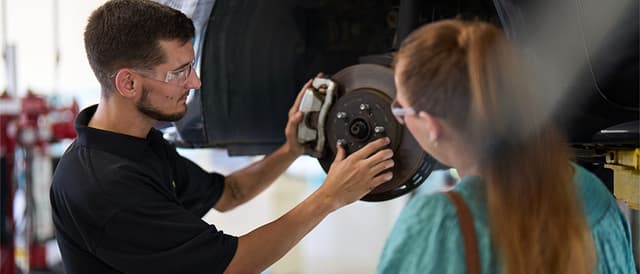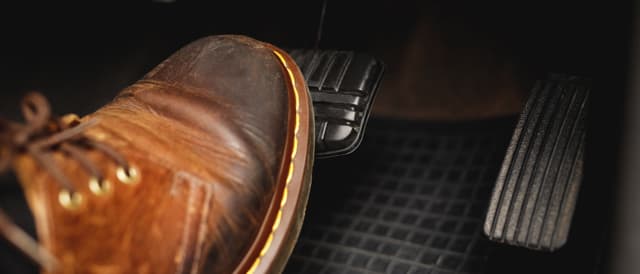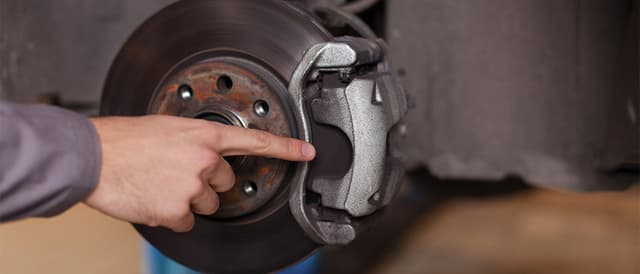How Long Do Brake Pads Last? A Guide to Brakes
By Mavis Tire Team
Published 02/06/2025

Keeping your car in good condition helps increase the lifespan of your vehicle and keeps you safer on the road. Understanding how long brake pads last, how to repair a damaged tire, and more will help keep your car in its best shape. When it comes to your brakes, many factors can impact the overall lifespan, including your driving style, driving habits, and other driving conditions.
So when should you replace your brake pads? If your brakes are squealing every time you use them, it may be time for a brake repair at . However, how do you know when you need brake service before the squeaking begins?
There are a few good ways to monitor your brakes' condition and take care of them before they become a problem. First, let's discuss the main parts of your brakes and warning signs to look for when there may be a problem.
Disc or Drum Brakes
A passenger car’s brakes are one of two types: disc or drum. Cars manufactured before 1970 or so may have drum brakes in the front and the rear. Modern vehicles manufactured after that will either have front disc brakes and drum brakes in the rear or disc brakes on all four wheels.
When you apply the brakes, brake fluid travels to the caliper and squeezes against the brake rotor like a clamp, which slows the wheel and stops the car. The same thing happens with the drum brakes, except the brake fluid travels to the wheel cylinder and pushes out against the shoes when you apply the brakes. Drum brakes may save a bit on fuel economy, but they are harder to reach for a brake service, replacement, and inspection.
Check Your Brake’s Condition
The first thing you can do is to know what your brakes look like when they're in good shape. Get down on the pavement next to your wheel and peek inside. In most cars, the wheels are designed so you can see the brake pad to gauge whether or not it needs attention.
A good brake pad will be relatively clean with little accumulation of brake dust. That's the actual material of the brake pad being worn off by friction with the disc or drum. Brake pads wear, but too much means it's wearing down too thin to be effective. If you've had some brake dust buildup, but have noticed there is less of it, it could easily be because there's not enough brake pad material remaining, meaning your brakes need further inspection.
Some brake pads have a wear indicator groove that lets you know how much of the material has come off; there should be at least a quarter-inch thickness of the material. Most brake pads have a metal pin or clip buried inside that is exposed through wear, then scrapes and pings on the disc to let the driver know the pads need replacement. The groove is visually noticeable, and the pin or clip is audibly noticeable.
The disc or drum should be in good condition, not sporting any scrapes or gouges. Obvious damage will decrease the brake responsiveness and should be replaced. When you press the brake pedal, it should be smooth and not produce vibration in the pedal or the steering wheel. Either of those could be a sign to replace your brakes sooner rather than later.
While driving, notice whether the car is pulling to one side or another, which could be a sign that a brake caliper is sticking, decreasing brake responsiveness while making it harder to steer.
How Do I Know When It’s Time to Change My Brake Pads?
Knowing when to replace your brake pads can help prevent unnecessary wear on other aspects of your car’s brake system, such as the rotors and calipers. Here are signs that your brake pads may need to be replaced:
Squealing when braking: This is one of the most common signs of worn out brake pads. You’ll hear a squealing noise or screeching sound when applying pressure to your brakes.
Longer time to stop: Does it seem like your car is taking a longer distance to come to a full stop? This may be because the brake pads are worn out.
Vibration when braking: If your vehicle begins to vibrate as you start braking, this may also be a sign that the brake pads are worn out.
How Can You Slow Down the Process of Brake Pad Wear?
Driving on the highway will reduce the wear on your brake pads. Gradually slowing down instead of slamming on your brakes can also delay the wear. If you’re driving down steep terrain, minimizing the pressure on your brakes through the descent can also help.
How Much Does It Cost to Replace Brake Pads?
There are several factors that can impact the replacement cost of your brake pads, including the type of brake pads, whether your car has disc or drum brakes, the wear and tear on other brake components, and the type of vehicle you drive. Some cars, especially luxury vehicles, may cost more for replacement brake pads and labor.
Overall, costs to replace brake pads vary and bringing your vehicle to your local Mavis will allow you to take advantage of brake service specials Mavis often runs.
Common Brake Issues
If your car vibrates when using the brakes, it could be a larger problem than just a sticky caliper: It could also indicate a warped rotor. That could stem from severe overworking of the brakes or misaligned wheels. Regardless, it's a good idea to check what the cause is.
When pressing on the brake pedal, you'll want to look out for the brake being too slow to engage, requiring it to be almost to the floor before braking. That might indicate a fluid leak, which you can check by putting a piece of cardboard under the car overnight. Any brake fluid leaking will be almost colorless, and it will give a rough indication of the position of the leak.
A brake engaging too quickly, barely being tapped before throwing the car into a standstill, might indicate that you need to replace the brake fluid. A brake being too hard to engage might indicate that you have a brake line blockage. Any of these are potential reasons to get your brake systems checked.
In most cases, you should have your brakes checked when you go in for routine automotive service, or roughly every six months. But now that you have an idea of what to look for, you can keep track of your brakes in between.
Best Practices for Brake Pad Replacement
How fast do brake pads wear out?
The speed that your brake pads wear out depends on your driving style, the type of driving you do — whether highway or urban, and how much you are driving. At Mavis Tires & Brakes, we check brake pads at 30,000 miles.
How often should brake pads be replaced?
Your brake pads should be replaced as needed, depending on their wear and tear. To know when they need to be replaced, watch for warning signs, such as squealing when braking, more difficulty stopping quickly, and vibration when braking. And know that the experts at can assist you with a complete brake evaluation.
Rely on for Brake Replacement Services
If you need new brakes, or you’re concerned about the quality of your current brake pads, head to your local Mavis to receive a full inspection. Mavis can help you with all of your brake and auto needs. Schedule an appointment at your local Mavis today.
Our in house tire experts are always available to help you find a great tire.

Our in house tire experts are always available to help you find a great tire.




